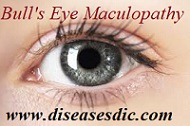Definition
Bull’s eye maculopathy describes a number of different conditions in which there is a ring of pale-looking damage around a darker area of the macula. The macula can often appear to have circular bands of different shades of pink and orange. Age of onset and severity of sight loss varies, and it can be inherited in many ways.
Bull’s eye maculopathy is a rare dystrophy, also known as benign concentric annular macular dystrophy (BCAMD). It causes a dartboard, or ring-shaped, a pattern of damage around the macula. This characteristic damage can also be caused by other inherited retinal conditions, or by long-term use of drugs which suppress the immune system as part of treatment for lupus or rheumatoid arthritis.
Bull’s eye maculopathy
Pathophysiology
The mechanisms by which the degeneration occurs in this striking distribution are not well understood. The appearance may correspond to the pattern of lipofuscin accumulation in the cells of the retinal pigment epithelium (RPE), at the posterior pole and shows a depression at the fovea, thus explaining the annular pattern and central sparing.
Furthermore, the small area of central sparing was postulated as being due to a photoprotective effect of the high foveal concentration of luteal pigment. The initially spared center usually becomes involved during the disease, at which point the diagnosis of BEM can no longer be made.
Causes of bull’s eye maculopathy
Causes of Bull’s Eye maculopathy include
- Cone dystrophy
- Clofazimine maculopathy
- Cone-rod dystrophy
- Fucosidosis
- Chloroquine (CQ) or hydroxychloroquine (HCQ) or Plaquenil toxicity
- Juvenile Batten’s disease
- Ceroid lipofuscinosis
- Benign concentric annular macular dystrophy
- Stargardt’s and fundus flavimaculatus
- Central areolar choroidal dystrophy
- Foveal atrophy of RPE secondary to AMD
- Fenestrated sheen macular dystrophy
Risk factors of bull’s eye maculopathy
- Taking long-term CQ or HCQ
- Age over 60 years
- Presence of renal or liver disease, as chloroquine is dependent on both hepatic and renal clearance
- Preexisting retinal disease, e.g., patients with macular degeneration who have less healthy retina, or have an underlying disease which may make it difficult to recognize the early functional loss or pigmentary damage from drug toxicity.
- Habitus with high-fat level (unless chloroquine dosage is appropriately low)
Symptoms
- Blurred vision, especially in the central bit of vision
- Dislike of bright light (photophobia)
- Poor color vision
- Diminished visual acuity
- Reduced visual fields with both white and red test objects
- Fast to-and-fro movements of the eyes (nystagmus)
- Dyschromatopsia
- Foveal hyperpigmentation
- Macular dystrophy
Complications of bull’s eye maculopathy
- The initial maculopathy lesions blunting or loss of the foveal reflex
- Parafoveal retinal pigment epithelium irregularities
- Light parafoveal hypochromic lesions
Diagnosis and test
History
For retinopathy, patients should be asked about poor central vision, change in color vision, central blind spots, difficulty reading, and metamorphopsia.
Physical examination
A physical exam should focus upon the condition that required hydroxychloroquine therapy to be initiated.
Differential diagnosis
The differential diagnosis includes age-related macular degeneration, cone dystrophy, rod and cone dystrophy, Stargardt’s disease, neuronal ceroid lipofuscinosis, and fenestrated sheen macular dystrophy
Imaging techniques
- Fluorescein angiography will demonstrate a hyperfluorescent window defect in a bull’s eye pattern in the area of RPE loss.
- Humphrey 10-2 visual fields can demonstrate (para) central scotomas.
- Multifocal electroretinogram may show “moat around a small hill” appearance.
- Optical coherence tomography (OCT) can detect early retinopathy via RPE and photoreceptor loss in the parafoveal regions Newer technologies such as spectral domain OCT
- Autofluorescence can detect even earlier retinopathy before the visual loss.
Treatment and medications
There is no good way to treat inherited genetic eye conditions that cause Bull’s Eye Maculopathy. Usually, there is also no good way to stop the sight loss that often occurs along with Bull’s Eye Maculopathy. But many things can be done to help visually impaired children.
Prevention of bull’s eye maculopathy
- Since CQ and HCQ are essential drugs to control the effects of connective tissue diseases and the patients sometimes need higher doses to control the diseases, it is suggested that patients taking long-term CQ or HCQ should undergo one baseline ophthalmologic screening examination at the first visit and annual screening thereafter.
- Moreover, the routine 250 mg CQ and 200 mg HCQ tablets should be used cautiously, or divided, especially in patients with low body weight.

